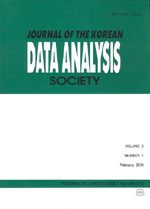서울시 환경요인과 월별 뇌혈관 질환 사망자의 연관성
Effects of Environmental Factors on Monthly Cerebrovascular Mortality in Seoul
- 한국자료분석학회
- Journal of The Korean Data Analysis Society (JKDAS)
- Vol.11 No.2
-
2009.04687 - 698 (12 pages)
- 10

본 연구는 환경요인과 한국인의 3대 주요사인으로 알려진 뇌혈관 질환 사망자 사이의 연관성을 규명하기 위해 1995년 1월부터 2004년 12월까지의 서울시 월별 뇌혈관 질환 사망자 자료와 대기오염물질( SO₂, O₃, NO₂, PM10), 기상변수(평균기온, 평균상대습도)를 사용하여 분석을 실시하였다. 분석에 앞서 콜모고로프-스미르노프 검정을 통해 서울시 월별 뇌혈관 질환 사망자가 음이항 분포를 따름을 검정하고, 기본 모형 하에서 6가지 환경요인들에 대한 최대 5개월간의 시차변수들의 상대위험을 비교하였다. 환경요인과 사망자 사이에 교락요인으로 작용할 수 있는 추세성분과 계절성분을 조정하고, 환경요인들의 지연효과를 고려하기 위해 환경요인의 시차변수들을 음이항 회귀모형에 고려하여 분석을 실시하였다. 분석결과 오존, 평균상대습도가 서울시 월별 뇌혈관 질환 사망자에 유의한 영향을 미치고 있는 것으로 나타났다.
In this paper, we investigate the association between environmental factors and monthly mortality of cerebrovascular disease over 10 years (January 1995 - December 2004) in Seoul. We show that monthly cerebrovascular mortality has a negative binomial distribution using Kolmogorov-Smirnov test. To determine lag effects of environmental factors upon monthly mortality, we compare the relative risks of six different lag models with a maximum lag of 5 months. We also conduct correlation analysis for each environmental factor with its lagged variables and monthly mortality. We employ a negative binomial regression model to regress monthly cerebrovascular-disease death counts for four air pollutants, temperature and relative humudity, controlling for long-term and seasonal trends. We conclude that 4-month and 5-month lagged concentration of O 3 and 4-month lagged relative humidity are significant risk factor for cerebrovascular mortality.
1. 서론
2. 음이항 회귀모형
3. 사례연구
4. 논의 및 결론
참고문헌
(0)
(0)